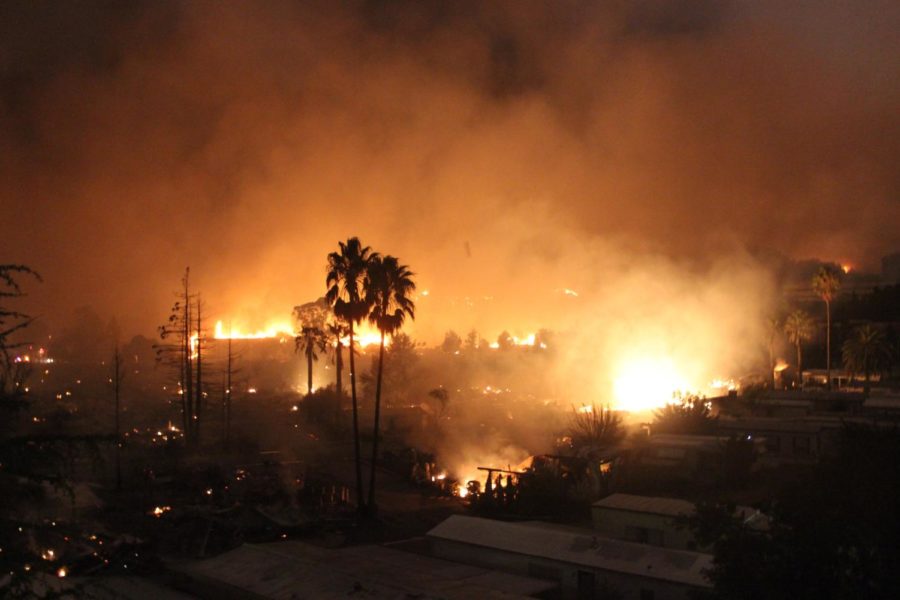The Diablo winds blow warm air to the coast, but this time they brought something more diabolical—the worst wildfires in California history.
The fires that claimed lives, destroyed homes and displaced tens of thousands of Sonoma County residents held a community hostage in fear and vigilance for more than a week and likely changed it forever.
“This is my 40th national deployment,” said Joseph Apicelli, 60, a 12-year American Red Cross veteran volunteer. “I’ve seen snowstorms, ice storms, hurricanes, tornadoes, wildfires, flooding and to me, this is one of the biggest disasters I’ve ever seen.”
At least 650 Santa Rosa Junior College students and 60 SRJC employees reported they had lost their homes and approximately a quarter were evacuated, according to a survey the SRJC Research Office conducted that received a 60 percent response rate.
“It’s catastrophic,” said SRJC President Dr. Frank Chong.
As those whose homes were spared begin to repopulate their neighborhoods, the wildfires that killed at least 42, burned more than 100,000 acres and destroyed nearly 7,000 structures were 91 percent contained Tuesday night.
It took thousands of firefighters converging from several western states and from as far away as Australia two weeks to finally control.
“This is truly one of the greatest—if not the greatest—tragedy California has ever faced,” Gov. Jerry Brown said. “The devastation is just unbelievable. It’s a horror that no one could have imagined.”
The First Night: The Tubbs Fire
At approximately 8:30 p.m. Oct. 8, the Tubbs Fire began on its namesake road near Calistoga. Diablo winds up to 70 mph propelled the forest fire towards Mark West Springs and Riebli roads in Santa Rosa, destroying homes in rural areas on its way.
Mass evacuations began across the county and throughout northern Santa Rosa as the Tubbs Fire tore through whole neighborhoods. By 2 a.m., it had reached Fountaingrove and Larkfield/Wikiup, and then moved into Mark West Estates and the Journey’s End mobile home part.
Within an hour, it had jumped across Highway 101 and destroyed, homes in the Coffey Park neighborhood. The fire reached as far south as Steele Lane, coming within one mile of SRJC.
Due to the fire’s size and speed, first responders were initially unable to fight the flames and focused on saving lives over property.
“The wind was blowing so hard there was no way to stop it,” said Healdsburg Fire Engineer Ruben Mandujano. “I was lucky to be with a captain who was at the Valley Fire. Going through that and seeing this is what prompted us to start knocking on doors,”
Local agencies worked through the night to evacuate areas within the fire’s grasp and by sunrise Oct. 9, the fire had destroyed 3,000 homes and many more nonresidential structures, while mandatory and advisory evacuations had been issued for most of Sonoma County.
The shelter at Finley Community Center in Santa Rosa filled up and evacuees from Sutter and Kaiser Hospitals were rerouted to the Veteran’s Memorial Center and the Sonoma County Fairgrounds.
Brown declared a state of emergency and first responders poured in from all over the state as 359,000 PG&E customers lost power. CAL Fire officials said at least 5,000 fire personnel converged on the county by Tuesday as 200 law enforcement officers from North Bay communities helped to facilitate evacuations, maintain road barricades and preserve order.
Seventy-seven cell-sites in Sonoma and Napa Counties went down, with some completely destroyed. Senator Mike McGuire said only 35 had been restored by Oct. 10.
Although structures continued to burn around Santa Rosa and Sonoma County, the majority of the damage the Tubbs Fire caused in populated areas ended on Oct. 9. Firefighters were able to extinguish fires still burning in Rincon Valley, although houses were lost and much of the area remained under mandatory evacuation for most of the week.
Of the three main fire complexes raging in Sonoma County, firefighters contained the Tubbs Fire first. Even though it continued northeast forcing the mandatory evacuation of the entire town of Calistoga on Oct. 12, firefighters had gained 50 percent containment by Oct. 14. CAL Fire reported containment increased to 94 percent on Oct. 24.
Annadel Ablaze: The Nuns Fire
The Tubbs Fire moved northwest, having done most of the damage on Oct. 9. While the Pocket Fire threatened Geyserville, the Nuns Fire, which started in Napa County, spread north to Annadel State Park and began to threaten southeastern Sonoma County.
By Monday night, much of Kenwood, Glen Ellen and Sonoma were under mandatory evacuation due to the Nuns Fire. On Oct. 10, some firefighters had been working for more than 24 hours without food or rest and despite their efforts, the fire was zero-percent contained.
“You have people working on your behalf who themselves have lost their homes, whose families have been displaced and who’ve gone hours and hours without sleep. They’re working overtime doing everything they can possibly do to get through this,” Rep. Mike Thompson said.
The Nuns Fire was the largest of the three fires, and by Oct. 24, it had burned one-and-a-half times the acreage as the Tubbs Fire and three times that of the Pocket Fire. Due to the expansive range of the fires, any change in winds would have put more residential areas in the fire’s destructive path.
“If the weather stays as it is right now, we’re good. If the wind picks up, we’re screwed,” said Art Gleck, a CAL Fire firefighter while he worked on Lawndale Road near Oakmont on Oct. 10. “We don’t even have containment. It’s jumping around so fast it’s not even funny.”
Smoke from the fires caused residents to don N-95 masks all over the Bay Area. The Bay Area Air Quality District activated an air quality alert for the Bay Area Oct. 10, calling the pollution unprecedented. A NASA satellite image showed that wildfire smoke traveled all the way to San Diego.
The Nuns Fire continued its descent through Annadel and across Bennett Valley Road, prompting the evacuation of county lands, as well as the Annadel Heights neighborhood and the area around the Bennett Valley Golf Course in Santa Rosa.
Firefighters conducted their first controlled burns in Annadel State Park on Oct. 11, sending huge columns of white smoke into the air.
“It was like a mushroom cloud,” said Bennett Valley resident Luca De Lorenzis, 23. “The fire moved faster than any I’ve seen.”
CAL Fire public information officers said firefighters used controlled burns to contain fires and protect residences by burning fuel sources while the winds were favorable. Although Sonoma County residents stayed vigilant in light of “red flag” warnings for higher winds through Oct. 16, the projected winds didn’t materialize and firefighters continued to gradually gain control.
Approaching Containment:
On Oct. 14, officials evacuated parts of eastern Santa Rosa as the Oakmont and Nuns Fires jumped across Highway 12 toward Mt. Hood. At this point, firefighters reached 15 percent containment on the Nuns Fire and 10 percent on the related Oakmont Fire.
CAL Fire reported 85 percent total containment on Oct. 20 and projected complete containment of all fires by Oct. 24.
The week of Oct. 14, authorities began lifting nearly all evacuated areas still standing in Sonoma County as law enforcement began to allow restricted access to the more devastated neighborhoods such as Coffey Park and Fountaingrove.
Officials estimate the fires destroyed 5 percent of housing in Santa Rosa, a city already beset by a housing-supply crisis.
Sonoma County Sheriff-Coroner Robert Giordano debunked reports that a homeless Sonoma man of Hispanic origin caused the fires and an investigation into the cause of the fire continues.
Some officials speculated that PG&E power-lines may have started the fires, and Mandujano confirmed reports of arcing power-lines on the night of Oct. 8. Power-lines are not an unusual cause of forest fires in high wind conditions.
Healdsburg Fire Engineer Ruben Mandujano confirmed reports of arcing power-lines on the night of Oct. 8. Power-lines are not an unusual cause of forest fires in high wind conditions.
On Oct. 23, CAL Fire extended its projection for total containment from Oct. 25 to Oct. 27 due to higher temperatures and windy conditions.
Twenty-one people remain missing in Sonoma County. Authorities are using DNA analysis to identify five unidentified remains of the 23 confirmed fatalities in Sonoma County.
Law enforcement’s goal this week is to facilitate re-entry of residents to burned areas and repopulate persons whose homes are still habitable.
As evacuees returned to their homes, Bay Area law enforcement agencies began to leave the county though the National Guard remains.
“We’re really working on recovery,” Giordano said. “We’re really working on putting the community back together. It’s going to be a long process.”
Setting the Stage for a Disaster:
Increased rainfall in early 2017 ended a years-long drought and brought a particularly verdant spring; the resurgent plant-life coupled with an unusually hot late-summer created an abundance of dry foliage and provided fuel for the worst wildfire disaster the state has ever seen.
An as-yet-unknown ignition source combined with hurricane-strength winds and the proximity of Sonoma County residential communities to forested areas created the perfect formula for catastrophe, according to Windsor Fire Prevention Officer Cindy Foreman.
“The wild-urban-interface are these beautiful neighborhoods we build in these beautiful areas of our county that sit right in heavy timber, heavy forest, heavy grasslands with difficult access,” Foreman said. “Beautiful views—but it comes at a cost.”




